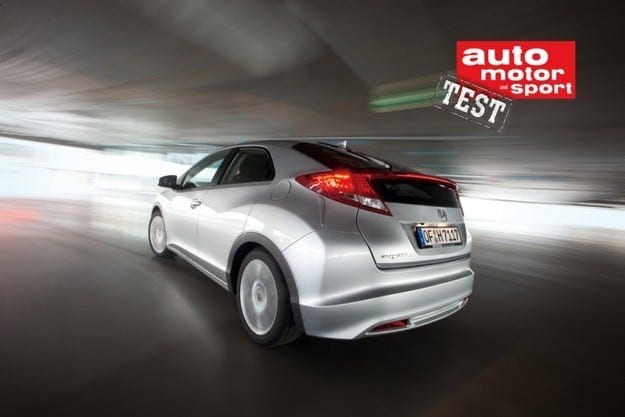
Test drive Honda Civic: individualist
Content

Courage has always been considered a particularly positive character trait. With the new version of the Civic model, Japanese manufacturer Honda proves once again that this also applies to the automotive industry.
Honda demonstrates boldness and remains true to the futuristic shapes and fast-paced silhouette of the next generation Civic. The front is low and wide, the windshield is heavily sloped, the side line slopes steeply backward, and the taillights go into a mini spoiler that splits the rear window in two. The Civic is definitely one of the most striking faces we can find in the modern compact class, and Honda deserves credit for that.
The bad news is that the car's irregular shapes lead to some purely practical weaknesses in everyday life. If the driver is taller, the upper edge of the windshield comes close to the forehead, and there is not much room for the heads of the second row passengers either. The massive C-pillars and the eccentric rear end, in turn, virtually eliminate the driver's view from the driver's seat.
Neat house
The interior shows a quantum leap over the previous model - the seats are very comfortable, the materials used look better than before, the digital speedometer is in perfect position. The TFT-screen of the i-MID on-board computer is also ideally located, but its functions are not very logically controlled, sometimes even frankly strange. For example, if you want to change from daily to total mileage (or vice versa), you will have to search until you find one of the system's submenus using the steering wheel buttons. If you decide to change the current value with average fuel consumption, then you will need to study what is written between pages 111 and 115 in the car's owner's manual to understand that this otherwise simple procedure can only be performed with the engine turned off. When it's time to fill up (it's good to go back to page 22 of the manual), you'll find out that the fuel cap release lever is low and deep to the left of the driver's feet, and it's not quite that easy to reach. simple job.
Of course, these shortcomings in ergonomics do not detract from the undeniable merits of the new Civic. One of them is the flexible interior transformation system, which traditionally evokes sympathy from Honda. The rear seats can be tilted up like movie theater seats, and if needed, all seats can be folded down and sunk into the floor. The result is more than respectable: 1,6 by 1,35 meters of cargo space with a completely flat floor. And that's not all - the minimum boot volume is 477 liters, which is much higher than usual for the class. Additionally, a double trunk bottom is available, opening up an additional 76 liters of volume.
Dynamic temperament
Obviously, the Civic claims to be a good companion on long journeys, as driving comfort has also been improved. The rear torsion bar now has hydraulic bearings instead of the existing rubber pads, and the re-tuned front shock absorbers should provide a more relaxed ride on uneven ground. At high speeds and well-groomed roads, the ride is really great, but at a slow pace in urban conditions, the bumps cause even more unpleasant impacts. The reason for this is probably the desire of the Honda Civic to have a sporty touch in its behavior. The steering system, for example, actually behaves almost like a sports car. The Civic easily changes direction and follows its exact line. However, when driving at high highway speeds, the steering is too light and sensitive, so the steering wheel requires a calm hand.
For a modified 2,2-liter diesel engine of 1430 kilograms Civic is clearly child's play - the car accelerates even faster than the factory data, its dynamics are wonderful. Feeling good behind the wheel is also ensured by exceptionally precise gear shifting and short gear lever travel. With a maximum torque of 350 Nm, the four-cylinder engine is one of the leaders in traction in its class and accelerates impressively at high and very low speeds. The Golf 2.0 TDI, for example, is 30 Nm less and far from being as temperamental. Even more encouraging news is that, despite a generally dynamic driving style during the test, the average fuel consumption was only 5,9 l / 100 km, and the minimum consumption in the standardized cycle for economical driving was 4,4. l / 100 km. Pressing the "Eco" button to the left of the steering wheel alternately changes the settings of the engine and the start-stop system, and the air conditioning system switches to economy mode.
The reason that the Civic did not receive the fourth star in the final rating was the pricing policy for the model. Indeed, Honda's base price is still reasonable, but the Civic doesn't even have a rear wiper and trunk lid against it. Anyone who wants to get the missing attributes must order equipment of a much more expensive level. Anyway, the surcharge for options such as parking sensors, cruise control and xenon headlights seems too salty for a compact model.
Evaluation
Honda Civic 2.2 i-DTEC
The new Civic benefits from its agile yet fuel efficient diesel engine and smart seat concept. Interior space, visibility from the driver's seat and ergonomics need improvement.
technical details
| Honda Civic 2.2 i-DTEC | |
|---|---|
| Working volume | - |
| Power | 150 k.s. at 4000 rpm |
| Maximum torque | - |
| Acceleration 0-100 km / h | 8,7 with |
| Braking distances at a speed of 100 km / h | 35 m |
| full speed | 217 km / h |
| Average consumption fuel in the test | 5,9 l |
| Base Price | 44 990 levov |

